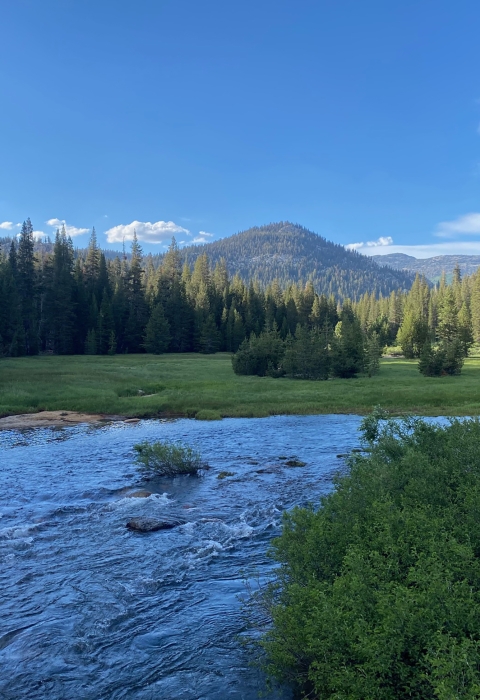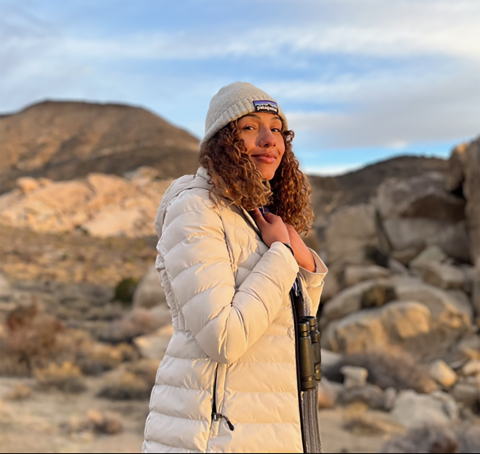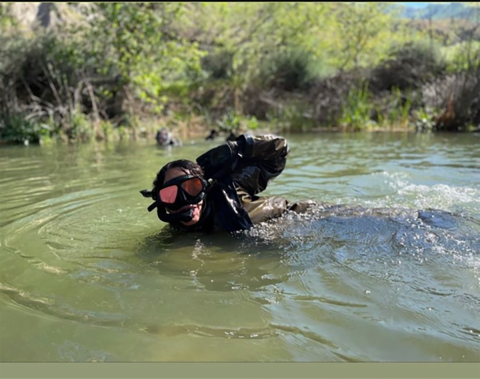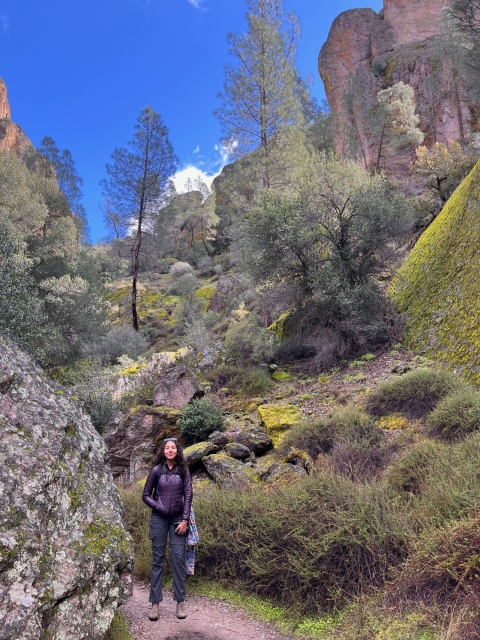Kayla Schneider (KS) is a Science in the Service intern at the Ventura Fish and Wildlife Office, working on a Geospatial Information Systems (GIS) project with the North Coast Division. She is interviewed by Vanessa Morales (VM), bilingual communications specialist at the Ventura Fish and Wildlife Office. Read on to learn about why Kayla thinks it is okay to take the road less traveled, and how it can make individuals and their team stronger.
VM: Hey, Kayla! You’re halfway through your Science in the Service internship! Can you tell me about you and your project?
KS: I am an employee of the American Conservation Experience (ACE), which partners with the U.S. Fish and Wildlife Service and other Department of the Interior agencies to provide current students and recent graduates with opportunities to gain experience. My role is with the Ventura Fish and Wildlife Office in Ecological Services program with the North Coast Division.
I am working on a project that analyzes the habitat of the endangered Santa Cruz long-toed salamander, which is a subspecies of long-toed salamander that is endemic to Santa Cruz and Monterey County. The project involves building a series of maps using various forms of geospatial software to delineate land use change within the species range over the past 30 to 40 years.
VM: What degree are you currently working towards?
I attended Eastern Michigan University for a few years and then took a break when I moved to Ventura County. I didn’t know which direction to go in for my career path or where I wanted to end up. After taking a few years away and reconsidering, I realized that I had always had this desire to pursue conservation and resource management.
So now, I am studying environmental science and resource management at California State University Channel Islands. It is a great interdisciplinary program that made me realize how multidimensional conservation really is. In my program, I have taken biology classes, chemistry classes, eco-toxicology classes, and environmental law and policy classes. It was during my population and organismal biology class that I realized how cool biology was!
VM: Awesome! Can you pinpoint something from your past that catalyzed the desire to pursue this direction?
KS: My childhood was informative in my decision to pursue a conservation and resource management-related field. In Southeast Michigan, where I grew up, lakes and rivers are abundantly available. My grandparents had a cottage and a pontoon boat that my grandpa would take us fishing on over the weekends. I hold those memories so close to my heart. When I reflect on those moments, I recognized that I had always had an insatiable fascination with wildlife and the natural world. And I think that is really where it all began.
VM: Thank you for sharing those memories. What eventually led you to the Service?
KS: After re-enrolling in school, my passion for conservation was reignited when I started working as a field tech for a local water district. A good friend of mine mentioned opportunities for internships with the Fish and Wildlife Service, and she encouraged me to pursue those opportunities. I am so glad I did, because my interests and passion really align with the mission of the U.S. Fish and Wildlife Service.
VM: Is there a project from your schooling or internships that make you particularly proud?
KS: Yes, my senior capstone research is definitely one of my proud moments, especially since I went into it with limited GIS experience.
Interestingly, the project was done alongside the Ventura Fish and Wildlife Office. The research was focused on assisting and recovering Least Bell’s Vireo along the Santa Clara and Santa Ynez River. We used an existing habitat suitability model that was published by U.S. Geological Survey, and our project was uniquely focused on developing a framework that was accompanied by a mapping model. The mapping model was built to assist resource managers in identifying where the most effective areas to concentrate Least Bell’s Vireo recovery efforts were. In the end, we got so busy working on my capstone that we ran out of time to do any actual vireo surveys, but I am looking forward to assisting VFWO with surveys this spring!
Lastly, the project helped me realize that when you pursue something that’s challenging, it’s not only rewarding to see the end product you worked so hard for, but also what you learn about yourself in the process. No matter the experience level, with the right mindset and support system, we all have the capacity to learn something new.
VM: Thank you, I agree with that! Have you gained a conservation mentor along the progression of your career?
KS: My supervisor at the water district where I worked was an exemplary leader overall, but her love for wildlife was infectious. She really inspired me both professionally and personally to remain driven when facing adversity. We had a unique relationship because she was also a nontraditional student who came back to her education at a later point in time. I can recall several inspiring and uplifting conversations that were immensely helpful when I was going through a particularly challenging time with school and life demands. She introduced me to a poem called The Road Less Traveled by Robert Frost, which resonated with me, because it is about individualism and nonconformity. I really related to that as a nontraditional student.
Often, we have ideas or perceptions of where you think you should be versus where you are. I think it is so important in those times, to recognize that your journey is yours to embark on. Returning to my education after time away was intimidating, and at times I questioned if it was the right decision. To think about where I am today, I can't thank her enough for mentioning that poem to me. Our relationship and that poem reminded me that you're exactly where you're supposed to be.
The last few lines of the poem read “Two roads diverged in a wood, and I took the one less traveled by, and that has made all the difference.”
VM: Thank you for sharing the poem, Kayla! I agree, working with people from different walks of life is what makes our teams stronger. What is your opinion on the importance of diversity in conservation?
KS: I believe diversity is an indispensable part of conservation success. As conservationists, naturalists, and resource managers, we understand how important diversity is in an ecological sense. So, I have to think to myself, why wouldn’t the same principles of diversity be true for our work environments or apply to other areas of life? I really think that diversity drives and enhances the mission of conservation, and, in my opinion, successful conservation cannot move forward without it.
VM: Absolutely. Do you feel that the outdoors is for everyone?
KS: Accessibility to the outdoors is a fundamental right, and I firmly believe every individual should have the right to feel safe on our public lands and in our outdoor spaces. When we actively seek to dismantle existing barriers and confront institutions that perpetuate exclusivity, we can enable equitable access to the outdoors to create space for the next generation of stewards, naturalists, and conservationists.
VM: After having been on board for several months now, would you recommend a Science in the Service internship to others?
KS: I definitely would! This program is unique in the sense that it offers flexibility. The opportunity is great for someone who doesn’t have a super open schedule, recent graduates, or others who are trying to finish school. I’ve enjoyed my experience and there has been a lot of support and varied opportunities in the Science in the Service Fellowship. I would highly encourage anyone considering a career in wildlife management and conservation to apply!
VM: We have really appreciated your hard work! How do you spend your free time?
KS: I’ve been pretty busy lately, but I enjoy getting outside in any form or fashion. I love hiking, camping, photography, birding, and recently got back into running! If I’m not outside, I enjoy baking and spending time with family and friends.
VM: Thank you for sharing your journey to the Service, with us, Kayla!






